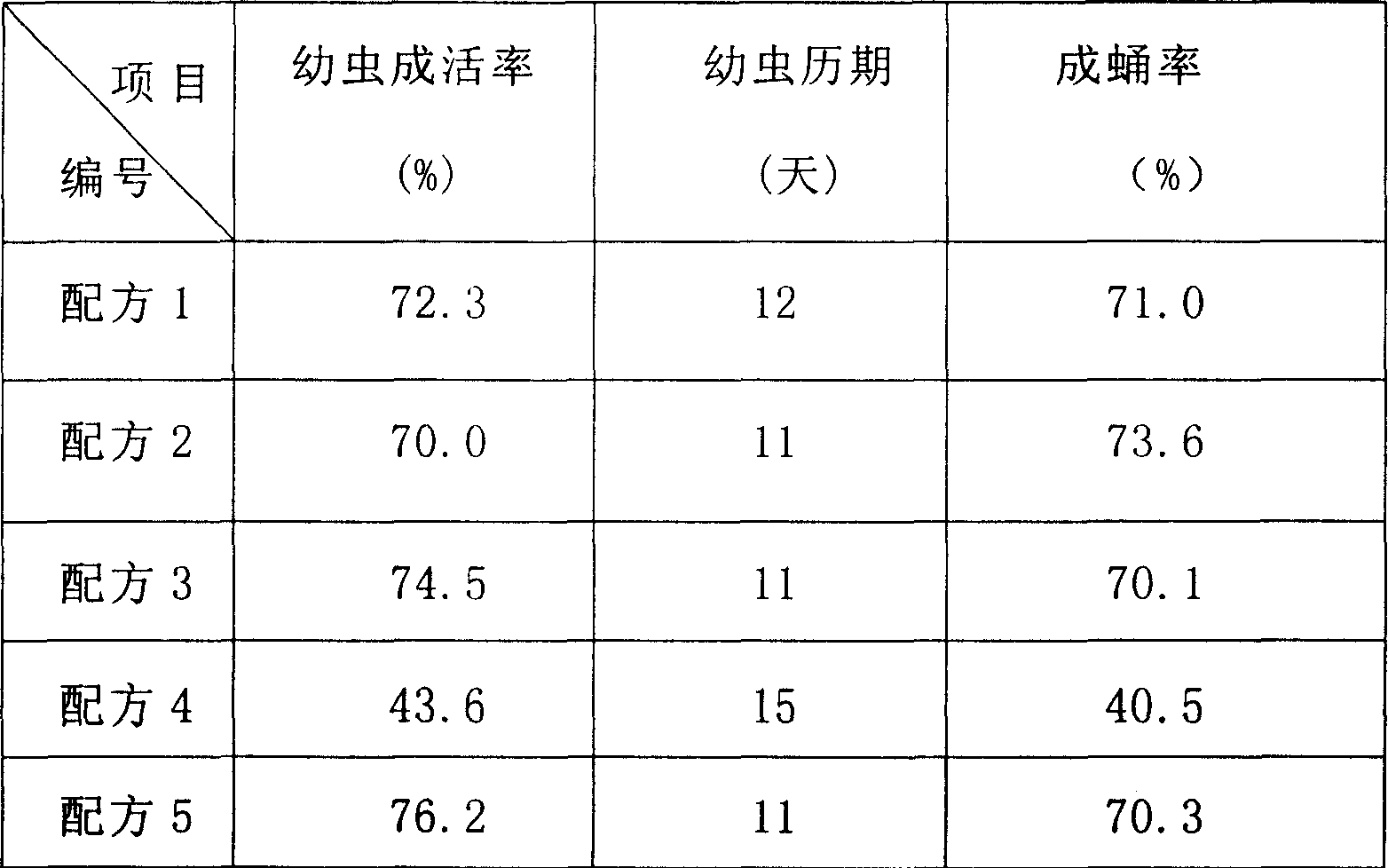Artificial feeding and generation method of Ectropis oblique hypulin W. and artificial feed for its larva
A technology of artificial feed and tea inchworm, which is applied in medical science, veterinary instruments, animal delivery, etc., can solve the problems that tea inchworm is difficult to complete the whole generation, the output of biopesticides is unstable, and large-scale production is difficult to achieve. The effect of high larva survival rate, overcoming adverse factors and shortening cycle
- Summary
- Abstract
- Description
- Claims
- Application Information
AI Technical Summary
Problems solved by technology
Method used
Image
Examples
Embodiment 1
[0038] Initially select 8000 eggs of tea looper. Routinely disinfect all tea geometrid eggs (soak them in 10% formalin solution for 1 hour, then rinse them with clear water and dry them in the shade), hatch 6080 larvae at 25°C, and artificially feed the tea geometrid larvae Heat and mix according to formula 2 in Table 1, pack into tea geometrid larva rearing containers, insert newly hatched larvae (inject 30-50 newly hatched larvae in each container), and put them into a healthy insect breeding room to raise , depending on the feed situation, the feed was replaced at regular intervals, and 4356 pupae became pupae in 11 days. The pupae were put into moist sand (humidity should be able to form a group with hands and let go and basically disperse) for 8 days, and 3910 pupae emerged. Worm 1253, male worm 2657, every 1 pair of adults is put into 1 container, adds nutrition No. 5 liquid (put into a diameter in every container and be the aseptic cotton ball of 1.5cm, nutrition is add...
Embodiment 2
[0040]12,280 eggs of tea geometrid larvae, the feeding method and environmental conditions are the same as those in Example 1, 8596 larvae were hatched under the condition of 25°C, the artificial diet for tea geometrid larvae was heated and mixed according to formula 1, and packed into the breeding container of tea geometrid larvae. The newly hatched larvae were inserted and raised in a healthy insect breeding room. After 12 days, 6018 pupae became pupae. After 9 days, the pupae were placed in moist sand, and 5115 adults emerged, including 1790 females and 3325 males. Each pair Put the adults into a container, add No. 5 nutrition solution, the egg production is 152,150, the egg stage is 5 days, 111,069 larvae are hatched, and 10,000 larvae are left when they are raised to the 3rd instar, and the remaining 101,069 larvae replicate the virus to kill insects Agent, can be applied to 6700 acres.
Embodiment 3
[0042] Tea geometrid larvae 23140 grains, feeding method and environmental conditions are the same as in Example 1, under the condition of 25 ℃, 16429 larvae are hatched, and the artificial diet of tea geometrid larvae is heated and mixed according to formula 3, and then packed into the breeding container of tea geometrid larvae. The newly hatched larvae were inserted and raised in a healthy insect breeding room. After 11 days, 11,664 pupae became pupae. The pupae were placed in moist sand for 8 days, and 9,915 adults emerged, including 3,966 females and 5,949 males. Each pair Put the adults into a container, add No. 5 nutrition solution, the egg production is 341076, the egg stage is 5 days, 255807 larvae are hatched, and 10000 larvae are left when they are raised to the 3rd instar, and the remaining 245807 larvae replicate the virus to kill insects Agent, can be applied to 15000 acres.
PUM
 Login to View More
Login to View More Abstract
Description
Claims
Application Information
 Login to View More
Login to View More - R&D
- Intellectual Property
- Life Sciences
- Materials
- Tech Scout
- Unparalleled Data Quality
- Higher Quality Content
- 60% Fewer Hallucinations
Browse by: Latest US Patents, China's latest patents, Technical Efficacy Thesaurus, Application Domain, Technology Topic, Popular Technical Reports.
© 2025 PatSnap. All rights reserved.Legal|Privacy policy|Modern Slavery Act Transparency Statement|Sitemap|About US| Contact US: help@patsnap.com

